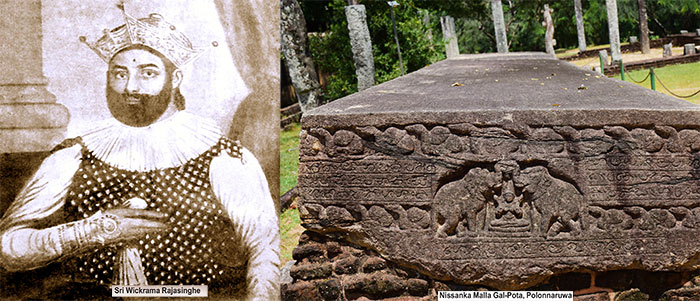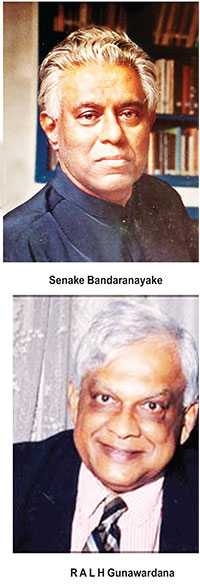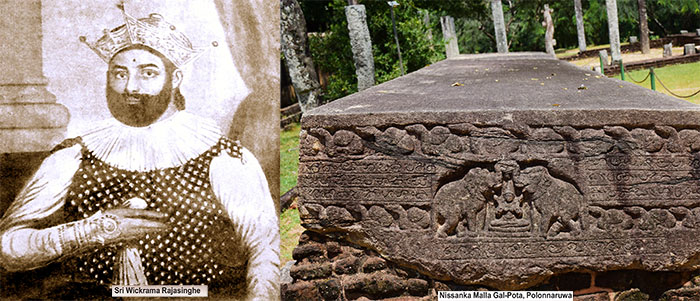Charting a new history, for a new future

Source: The Island
For Sinhala nationalists, I daresay the history of Sri Lanka remains the history of the Sinhala people. This begs two questions: one, who are these Sinhala people, and two, where does their history begin? The typical nationalist response to these would be, first, that Sinhala people are those who form the majority in the country, and second that their history begins with the advent of kinship as outlined in chronicles like the Mahavamsa.
But such responses ignore important historical considerations, like the fact that the kings of Sri Lanka, or at least the first among them, hailed from India, or that the chronicles refer to a civilisation that is supposed to have predated their arrival.
How do nationalists resolve these contradictions? They would probably contend that the island possessed a civilisation that was eminently different and superior to that which kings brought about here, while conceding that the latter also developed the country. After all, there are important debates over historiography within nationalist circles, boiling down to whether we to trace our ancestry back by 2,500 years, to the colonisation of the country by Indo-Aryan tribes, or by 10,000 years, to the formation of a pre-Indian, pre-Aryan civilisation supposedly free of external influences. Though there’s no real archaeological evidence for the latter view, there is no shortage of popular writers who speculate about Sinhala people being bearers of a culture predating the Indian influence.
It must be pointed out that the notion of race figures prominently in both cases. In fact, for Sinhala nationalists as much as for Tamil, Muslim, and other nationalists, race remains the primary consideration, the only priority. It is true that as R. A. L. H. Gunawardana has noted that in European languages the word race “dates only from about the sixteenth century”, while neither Sinhala nor Tamil has a satisfactory equivalent for it. Yet for nationalists, history is at best a series of encounters between ethnic groups. Thus, whether they are talking about a prodigal son from northern India conquering the island of Tampabanni or a ten-headed king ruling the island long before the arrival of that son, they reduce the history of the country to the history of a dominant group. This is essentialist scholarship at its crudest.
Nationalists, of course, can be flexible on these matters. They often are. For instance, one prominent Jathika Chintanaya intellectual claimed, at a public seminar, that the Nayakkar kings of Kandy could become Sinhalese after they had been absorbed to the Sinhala social structure in the same way that Victoria, despite not being proficient in English, could turn into an English queen. But on the same grounds, these intellectuals and commentators talk of terms like Sinhalathvaya as if they are etched in stone. While they would readily accept that the Nayakkars became Sinhala because they were kings and had to be benefactors or be seen as benefactors of Buddhism, they would deny that Muslims could be absorbed into Sinhala social structures or take part in Sinhala rituals. According to their logic, to “become” Sinhala is a preserve of a ruling class that cannot be allowed for other groups.

The case of Wath Himi Kumaraya, popularly known as Gale Bandara Deviyo, shows how this kind of essentialism can blind us to the intricacies of our history. While records are unclear about his origins, what we can gather from them is the account of a Muslim pretender to the throne being killed by a group of nobles, only to be venerated later by adherents of both Islam and Buddhism. The transformation of a Muslim usurper to a popular deity is of course a fascinating historical anomaly in a thoroughly Sinhala and Buddhist realm, but one which seems to be appreciated by few, if at all. Certainly, a racialist historiography would ignore or omit such details, while those who subscribe to such histories would be ignorant of them: I myself realised this the other day when, after I suggested that Gale Bandara was “Muslim”, a lad of 19 argued passionately that Buddhists should stop venerating him!
I am not certain to what extent local textbooks reinforce racialist accounts of local history. I am certain, though, that these texts do not inculcate in their readers an appreciation of the many groups that form the identity of the country. Paradoxically, while reinforcing ethnic or religious supremacy, textbook accounts borrow concepts steeped in Western ideology. The notion of race is just one example, as is the origin of terms like Aryan, which had to do with the identity of a ruling class rather than of a hegemonic ethnic community.
This is a paradox that writers who privilege the racialist dimensions of history are not bothered with: even in their rejection of “Western” notions of multiethnic identity, they subscribe to other dominant “Western” notions, which happen to be as pervasive, if not more so. How can we address such contradictions? How can we resolve them? A good first step would be to historicise and find out what can be done with them.
By the early 20th century, debates and polemics had begun to crop up over issues of racial identity, territorial rights, ethnic distinctions, and so on, a point Senake Bandaranayake has made in his essay on “The Peopling of Sri Lanka.” Those who took part in these discussions fell back on divisions that European philologists and orientalists had drawn, between ethnic groups, on the basis of certain characteristics such as dialect and dress type.
What these examinations left out, which scientific advancements have made it possible for us to ascertain today, were the commonalities that link communities together. As evident and common as certain biological traits may be within communities, these by themselves, as Bandaranayake and Gunawardana have noted, by no means warrant the use of categories like race, which are so fluid they can’t be used as markers of distinction.
Perhaps what lent credence to such essentialist views was the scheme that early historians adopted in their periodisations of local history. As in India, where colonial scholars made an arbitrary and imaginary distinction between classical Hindu and decadent Muslim phases, in Sri Lanka they drew lines between a pristine medieval culture and a decadent pre-colonial phase, the latter usually identified with the period of the Kandyan kings. Other scholars took a further step by identifying not the Kandyan kingdom but colonial rule as decadent, in stark contrast to the Anuradhapura and Polonnaruwa periods.
Whatever the biases of the scholar would have been, the drawing up of chronological divisions along these lines made it possible for popular writers to fit their racialist accounts of history within such schemes later on, though history, as Senake Bandaranayake and R. A. L. H. Gunawardana have shown, rebels against such chronologies.
The biggest omission made by those who saw history as a contest between ethnicities was the issue of caste, which remains the least understood social phenomenon in Sri Lanka. The stalwarts of the Marxist Left, including Hector Abhayavardhana, forayed into rural society at the height of the Suriya Mal and anti-malaria campaigns of the 1930s, making it possible for scholars to examine social stratifications from a materialist perspective. Yet, over the years, discussions of such stratifications have tended to wane.
To me this is a striking omission. Intra-group differences are as important as inter-group ones. They emphasise the rifts that exist, not only at the racial level between communities, but also at caste and class levels, within the same communities.
For the most, sadly, historians and writers, be they “Marxist”, liberal, or nationalist, have ignored these considerations. That has led to a situation where, while rejecting the racialist rhetoric of nationalists, liberal scholars have fallen back on criteria no different from those which nationalist ideologues adopt. Hence, accounts of Moor, Malay, Tamil, even Burgher contributions to Sri Lankan society valorise these communities in an ethnic light, portraying them as racial types against which nationalists bring up their claims of superiority. Whether or not they intend it, then, the most progressive of Sri Lankan scholars provide ammunition for nationalist debates, given that they also view history through an ethnic lens. Perhaps the best example for this would be the notion of “Tamil Buddhism” in Sri Lanka, raised by social scientists, and the knee-jerk rejection of such a thesis by Sinhala nationalists.
I believe the first step towards liberating Sri Lankan historiography from its fixation with ethnicity and racialism would be, as Senake Bandaranayake noted, to consider the history of ethnic formation in the country as a complex process involving “the convergence of various pre and proto-historic developments.” On the one hand, nationalist historians are adamant on constructing a Sinhala Buddhist identity. On the other, the liberals’ response frames the issue in racial terms and adopts the criteria used by their opponents, hence legitimising the latter. Both approaches lead to a dead-end, and so both should be discarded.
The solution, perfectly sensible in my view, would be to start examining history from the vantage point of other social phenomena, like caste. In doing so, we will be able to come up with a historiography which places emphasis on the differences separating groups as much as on the commonalities binding them. To quote Senake Bandaranayake here, “[a] study of Sri Lankan history, stripped of its myths and distortions and free of communalist bias on one side or the other, can do much to contribute to the historic process of the formation of an integrated polyethnic modern nation.” We obviously have a long way to go.

